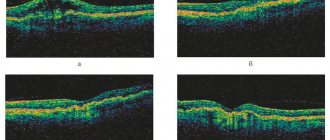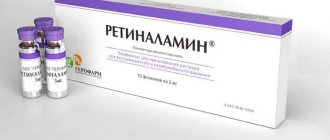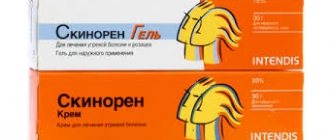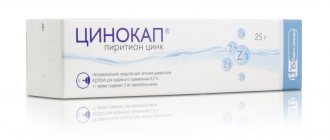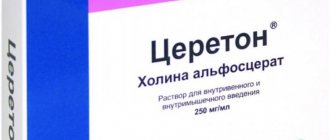| Composition and release form How the drug works When prescribed (indications) How to use (dosage) Contraindications for use Side effects of use | Overdose symptoms Drug interactions What to pay attention to Xalacom's analogs Prices in pharmacies Reviews from people who have used it |
Xalacom is a combined solution of antiglaucoma eye drops. It is used in ophthalmological practice for the treatment of intraocular hypertension, as well as open-angle glaucoma.
pharmachologic effect
Xalacom is a combined solution of eye drops that includes 2 active ingredients: latanoprost and timolol.
Latanoprost, as an analogue of prostaglandin F2a, has the ability to reduce IOP levels by activating the outflow of aqueous humor (increasing uvescleral outflow), which has an antiglaucoma effect. The effect of latanoprost on the production of intraocular fluid has not been reliably identified. Its ability to influence the blood-ophthalmic barrier has not been identified.
The second substance, timolol, being a non-selective beta-blocker, may have a slight sympathomimetic and membrane-stabilizing effect. When used topically, it lowers intraocular pressure by suppressing the production of aqueous humor and slightly increasing its outflow.
Interactions
With the simultaneous use of systemic beta blockers, slow calcium channel inhibitors, glycosides, antiarrhythmics, guanedine, the effects may be enhanced (hypotension, bradycardia, bronchospasm).
With the simultaneous use of two prostaglandin analogues, a paradoxical reaction (intraocular hypertension) is observed.
When combining the drug with epinephrine, mydriasis may develop.
With the simultaneous use of CYP2D6 inhibitors (paroxetine, quinidine, fluoxetine), the beta-blocking effect of the drug is enhanced.
Contraindications
- Individual hypersensitivity;
- Bronchial asthma and COPD;
- Severe cardiac dysfunction (chronic heart failure, atrioventricular block, sinus bradycardia, cardiogenic shock);
- Age up to 18 years;
- Pregnancy, lactation.
- Xalacom solution is prescribed with caution for inflammatory, congenital, neovascular, pigmentary, angle-closure glaucoma; open-angle glaucoma with pseudophakia; with aphakia, pseudophakia, rupture of the posterior lens capsule; patients at risk of macular edema.
Xalacom overdose, symptoms and treatment
Apart from eye irritation and conjunctival hyperemia, no other ocular or systemic side effects have been identified following an overdose of latanoprost. An overdose of timolol is characterized by the following symptoms: bradycardia, arterial hypotension, bronchospasm and cardiac arrest. If the above symptoms occur, symptomatic and supportive therapy is indicated. Tests have shown that timolol is poorly excreted during hemodialysis. If latanoprost is accidentally ingested, it must be taken into account that it undergoes extensive metabolism on its first pass through the liver.
Side effects
- Blepharitis, cataracts, conjunctivitis, visual impairment, allergic reactions (follicles, pinpoint hemorrhages), conjunctival reactions, pathological changes in the cornea (pigmentation, pinpoint keratitis, erosions), refractive changes, redness, pain, iris pigmentation, photophobia, ptosis, field loss vision, keratitis, decreased sensitivity of the cornea, diplopia.
- Disturbance of cerebral blood supply.
- Dry mouth, dyspepsia, nausea, diarrhea, retroperitoneal fibrosis.
- Sinusitis, upper respiratory tract infections, shortness of breath, bronchospasm.
- Hypercholesterolemia, diabetes mellitus.
- Angioedema, anaphylaxis, generalized rash, urticaria.
- Confusion, headache, dizziness, depression.
- Increase or decrease in blood pressure.
- Impotence, Peyronie's disease.
- Increased number of eyelashes, rash, chalazion.
- Arthritis, joint pain, muscle pain.
- Intermittent claudication, Raynaud's syndrome.
Xalacom, eye drops 2.5 ml
Manufacturer
Pfizer, USA
Compound
Eye drops in the form of a clear, colorless solution.
| 1 ml | |
| latanoprost | 50 mcg |
| timolol maleate | 6.83 mg, |
| which corresponds to the content of timolol | 5 mg |
Excipients:
benzalkonium chloride (in the form of a 50% solution) - 200 mcg,
sodium hydrogen phosphate anhydrous - 2.89 mg,
sodium dihydrogen phosphate monohydrate - 6.39 mg,
sodium chloride - 4.1 mg,
water for d/i - up to 1 ml.
pharmachologic effect
Due to the different mechanism for reducing elevated intraocular pressure between timolol and latanoprost, combined Xalacom eye drops provide a more effective reduction in IOP in patients compared to the use of each active substance separately.
Latanoprost increases the outflow of aqueous humor without affecting its production. Timolol reduces the formation of aqueous humor in the ciliary epithelium, without having a negative effect on the functioning of the heart muscle.
Latanoprost easily penetrates the cornea of the eye, concentrating maximum in the aqueous humor approximately 2 hours after instillation (during monotherapy). Almost not metabolized in the tissues of the eye. The half-life of latanoprost acid is 17 minutes. Metabolites are excreted in the urine and do not have pronounced biological activity.
Timolol is maximally concentrated in aqueous humor an hour after instillation of the drug (during monotherapy). Timolol is partially absorbed systemically, appearing in the blood plasma after 10-20 minutes at a concentration of 1 ng/ml. The half-life from plasma is about 6 hours. Excreted in urine.
After instillation of Xalac eye drops, the concentration of latanoprost acid in the aqueous humor may increase after 1-4 hours (compared to monotherapy).
Pharmacokinetics
No pharmacokinetic interaction has been established between latanoprost and timolol maleate, although 1-4 hours after Xalacom administration, the concentration of latanoprost acid in the aqueous humor was approximately 2 times higher than with monotherapy.
Latanoprost
Suction
Latanoprost, being a prodrug, penetrates well through the cornea and is hydrolyzed to a biologically active form (acid). Cmax in aqueous humor is achieved 2 hours after topical application. The systemic bioavailability of latanoprost acid after topical application of eye drops is 45%.
Distribution
Vd is 0.16±0.02 l/kg. Latanoprost acid is determined in aqueous humor during the first 4 hours, and in blood plasma only during the first hour after topical application. Plasma protein binding is 87%.
Metabolism
Latanoprost undergoes hydrolysis in the cornea under the influence of esterases to form a biologically active acid. Latanoprost acid entering the systemic circulation is metabolized mainly in the liver by beta-oxidation of fatty acids with the formation of 1,2-dinor and 1,2,3,4-tetranor metabolites.
Removal
Latanoprost acid is rapidly cleared from blood plasma. T1/2 is 17 min. Plasma clearance is 0.4 l/h/kg. Systemic clearance is approximately 7 ml/min/kg. Metabolites are excreted mainly by the kidneys: after topical application, about 88% of the dose is excreted in the urine.
Timolol maleate
Suction
Cmax of timolol maleate in aqueous humor is achieved after 1 hour. Part of the dose is subjected to systemic absorption and 10-20 minutes after topical application of the drug, 1 drop in each eye 1 time / day (300 mcg / day), a Cmax of 1 is achieved in the blood plasma ng/ml.
Metabolism and excretion
Timolol maleate is actively metabolized in the liver. T1/2 of timolol maleate from plasma is about 6 hours. Metabolites, as well as some amount of unchanged timolol maleate, are excreted by the kidneys.
Indications
Xalacom is used to reduce elevated intraocular pressure in open-angle glaucoma. It is also prescribed for increased ophthalmotonus.
Use during pregnancy and breastfeeding
There have been no adequate controlled studies of the use of the drug in pregnant women. Use is possible only when the expected benefit to the mother outweighs the potential risk to the fetus.
Latanoprost and its metabolites may be excreted in breast milk; timolol maleate, when used in the form of eye drops, has also been found in breast milk. If it is necessary to use the drug during lactation, the issue of stopping breastfeeding should be decided, taking into account the risk of serious adverse reactions in breastfed newborns, as well as the importance of using the drug for the mother.
Use in pediatrics
The safety and effectiveness of Xalacom in children has not been established.
Contraindications
- Reactive respiratory diseases (including bronchial asthma or a history of its presence).
- Severe COPD.
- Sinus bradycardia.
- AV blockade II and III degrees.
- Clinically significant heart failure.
- Cardiogenic shock.
- Hypersensitivity to the components of the drug.
Use the drug with caution when:
- Inflammatory, neovascular, angle-closure or congenital glaucoma.
- Open-angle glaucoma in combination with pseudophakia.
- Pigmentary glaucoma (due to lack of sufficient experience in using the drug).
- Aphakia, pseudophakia with rupture of the posterior capsule of the lens.
- In patients with known risk factors for macular edema (cases of the development of macular edema, including cystoid, have been described during treatment with latanoprost).
Side effects
Clinical studies have not revealed any side effects specific to Xalacom eye drops. But the development of side effects associated with the use of latanoprost and timolol is possible.
The frequency of adverse reactions is presented according to the following classification: very often ≥10%, often ≥1% and
From the organ of vision: very often - increased pigmentation of the iris; often - visual impairment, blepharitis, cataracts, conjunctivitis, conjunctival lesions (follicles, papillary reactions of the conjunctiva, pinpoint hemorrhages, etc.), corneal lesions (erosions, pigmentation, keratitis, pinpoint keratitis, etc.), refractive errors, conjunctival hyperemia, irritation eyes (including burning sensation and itching in the eyes), pain in the eyes, photophobia, loss of visual fields, increased tear production.
From the endocrine system: often - diabetes mellitus.
Metabolism: often - hypercholesterolemia.
Mental disorders: often - depression.
From the nervous system: often - headache.
From the cardiovascular system: often - increased blood pressure.
From the skin and subcutaneous tissues: often - hypertrichosis, rash, itching and skin changes (irritation, dermatochalasis, etc.).
From the musculoskeletal system: often - arthritis.
Infections and infestations: often - sinusitis, upper respiratory tract infections and other infections.
Listed below are other adverse reactions that were observed during monotherapy with individual components of the drug Xalacom® (in addition to those listed above).
Latanoprost
On the part of the organ of vision: eye irritation (burning sensation, feeling of sand in the eyes, itching, tingling and foreign body sensation); transient point erosions of the corneal epithelium, eyelid edema, keratitis; lengthening, thickening, increasing the number and increasing pigmentation of eyelashes and vellus hair; iritis/uveitis; macular edema (in patients with aphakia, in patients with pseudophakia with rupture of the posterior capsule of the lens, or in patients with risk factors for the development of macular edema), incl. cystoid; change in the direction of eyelash growth, sometimes causing eye irritation; blurred vision, photophobia, changes in the periorbital region and eyelids leading to deepening of the upper eyelid sulcus, periorbital edema, iris cysts.
From the cardiovascular system: exacerbation of angina pectoris in patients with coronary artery disease, palpitations.
From the skin and subcutaneous tissues: rash, darkening of the skin of the eyelids and local skin reactions on the eyelids.
From the nervous system: dizziness.
From the respiratory system: asthma (including acute attacks or exacerbation of the disease in patients with a history of bronchial asthma), shortness of breath.
From the musculoskeletal system: muscle pain, joint pain.
Infections and infestations: herpetic keratitis.
Other: nonspecific chest pain.
Timolol (in the form of eye drops)
Allergic reactions: systemic allergic reactions, incl. anaphylaxis, angioedema, anaphylactic reactions, urticaria, itching, localized and generalized rash.
Metabolism: hidden symptoms of hypoglycemia in patients with diabetes mellitus.
Mental disorders: behavioral changes and mental disorders, incl. confusion, hallucinations, anxiety, disorientation, nervousness, depressive symptoms, memory loss, insomnia, depression and nightmares.
From the nervous system: cerebral ischemia, acute cerebrovascular accidents, dizziness, increased symptoms of myasthenia gravis, paresthesia, drowsiness, headache, fainting.
From the organ of vision: cystoid macular edema, decreased sensitivity of the cornea; symptoms and signs of eye irritation (eg, burning sensation, itching, gritty sensation in the eyes, increased lacrimation, redness), blepharitis, keratitis, blurred vision, dry eye mucosa, corneal erosion, choroidal detachment after filtration surgery; ptosis, visual impairment, incl. changes in refraction and diplopia.
From the organ of hearing and vestibular apparatus: tinnitus.
From the cardiovascular system: arrhythmia, bradycardia, AV block, chronic heart failure, cardiac arrest, intracardiac conduction block, palpitations, progression of angina, intermittent claudication, cold hands and feet, decreased blood pressure, Raynaud's syndrome.
From the respiratory system: bronchospasm (mainly in patients with previous bronchospastic diseases), cough, shortness of breath, nasal congestion, pulmonary edema and respiratory failure.
From the digestive system: diarrhea, dry mouth, impaired taste, dyspepsia, nausea, vomiting, abdominal pain, retroperitoneal fibrosis.
From the skin and subcutaneous tissues: alopecia, pseudopemphigoid, skin rash, psoriasis-like rash or exacerbation of psoriasis.
From the musculoskeletal system: SLE, myalgia.
From the reproductive system: decreased libido, impotence, sexual dysfunction and Peyronie's disease.
Other: anorexia, asthenia/fatigue, chest pain, edema.
Very rare cases of corneal calcification have been reported in some patients with significant corneal damage in association with the use of phosphate eye drops.
Interaction
There have been no specific studies on drug interactions with Xalac eye drops.
If calcium channel blockers, beta-blockers, antiarrhythmic drugs (including amiodarine and quinidine), cardiac glycosides from the digitalis group of drugs, cholinomimetics, narcotic analgesics, monoamine oxidase inhibitors, drugs that reduce the activity of catecholamines, are used simultaneously with timolol, a pronounced slowing heart rate and lowering blood pressure.
Topical use of two beta-blockers or two prostaglandins is not recommended.
With a history of spontaneous hypoglycemia, diabetes mellitus (especially labile), and taking insulin or drugs that lower blood glucose levels, beta-blockers should be prescribed with caution. The drug may mask the manifestations of acute hypoglycemia.
In some cases, pupil dilation was observed when timolol was used together with epinephrine, despite the fact that Xalacom as a monotherapy has virtually no effect on pupil size.
How to take, course of administration and dosage
Adults and elderly people are recommended to instill 1 drop 1 time per day into one or both eyes.
If one dose is missed, the next dose should be administered at the usual time.
Overdose
Latanoprost
Symptoms: in addition to eye irritation and conjunctival hyperemia, other undesirable changes in the organ of vision are not known with an overdose of latanoprost.
In case of accidental ingestion of latanoprost, it should be taken into account that 1 bottle of 2.5 ml of solution contains 125 mcg of latanoprost. More than 90% of the drug is metabolized during the “first pass” through the liver. IV infusion at a dose of 3 mcg/kg in healthy volunteers did not cause any symptoms, but when administered at a dose of 5.5-10 mcg/kg, nausea, abdominal pain, dizziness, fatigue, hot flashes and sweating were observed. These symptoms resolve 4 hours after stopping the infusion. In patients with moderate bronchial asthma, administration of latanoprost at a dose 7 times higher than the therapeutic dose did not cause bronchospasm.
Timolol maleate
Symptoms: cases of unintentional overdose of timolol maleate eye drops have been described, resulting in effects similar to those with systemic use of beta-blockers: dizziness, headache, shortness of breath, bradycardia, bronchospasm, cardiac arrest.
In an in vitro study, timolol maleate was shown to be readily cleared from plasma or whole blood upon dialysis. In patients with renal failure, timolol maleate was less dialyzable.
Treatment: in case of an overdose of Xalacom, symptomatic therapy is carried out.
Special instructions
The drug should be used no more than once a day, because more frequent use leads to a weakening of the IOP-lowering effect.
If the patient is using other eye drops at the same time, they should be used at least 5 minutes apart.
Benzalkonium chloride, contained in Xalacom eye drops as a preservative, is adsorbed into the material from which soft contact lenses are made. Before instillation of drops, lenses should be removed. You can put them on again after at least 15 minutes.
Latanoprost
Latanoprost may cause a gradual increase in brown pigment in the iris. Changes in eye color are caused by an increase in the number of melanin in the stromal melanocytes of the iris, and not by an increase in the number of melanocytes themselves. In typical cases, brown pigmentation appears around the pupil and extends concentrically to the periphery of the iris. In this case, the entire iris or parts of it become brown. In most cases, the color change is minor and may not be clinically detectable. Increased pigmentation of the iris of one or both eyes is observed mainly in patients with mixed iris color, containing a brown color as a base. The drug has no effect on nevi and lentigines of the iris; no accumulation of pigment in the trabecular meshwork or anterior chamber of the eye was noted.
When determining iris pigmentation for more than 5 years, no undesirable consequences of increased pigmentation were revealed, even with continued therapy with latanoprost. In patients, the degree of IOP reduction was the same regardless of the degree of iris pigmentation. Therefore, treatment with latanoprost can be continued in cases of increased iris pigmentation, but patients should be monitored regularly and, depending on the clinical situation, treatment may be discontinued.
Increased pigmentation of the iris is usually observed during the first year after the start of treatment, rarely after the second or third year. After the fourth year of treatment, this effect was not observed. The rate of pigmentation progression decreases over time and stabilizes after 5 years. In the longer term, the effects of increased iris pigmentation have not been studied. After stopping treatment, no increase in brown pigmentation of the iris was noted, but the change in eye color may be irreversible.
In connection with the use of latanoprost, cases of darkening of the skin of the eyelids have been described, which may be reversible.
Latanoprost can cause gradual changes in eyelashes and vellus hair, such as lengthening, thickening, increased pigmentation, increased thickness, and a change in the direction of eyelash growth. Changes in eyelashes are reversible and disappear after cessation of treatment.
Patients using drops to treat only one eye may develop heterochromia.
Timolol maleate
When beta blockers are used topically, the same adverse reactions may occur as with systemic use.
Patients with a history of severe heart disease should be closely monitored for early detection of symptoms of heart failure. With local use of timolol maleate, progression of Prinzmetal's angina, peripheral and central circulatory disorders, arterial hypotension, bradycardia, fatal heart failure, severe reactions from the respiratory system (including bronchospasm with fatal outcome in patients with bronchial asthma) may occur. .
Before undergoing major surgery, the advisability of gradual withdrawal of beta-blockers should be discussed. Drugs in this group impair the heart's ability to respond to reflex beta-adrenergic stimulation, which may increase the risk during anesthesia. Cases of prolonged severe arterial hypotension during anesthesia and difficulties in restoring and maintaining cardiac activity have been described. During surgery, the effects of beta blockers can be reversed by sufficient doses of adrenergic agonists.
Beta blockers can enhance the hypoglycemic effect of oral hypoglycemic agents and mask the symptoms of hypoglycemia. They should be used with caution in patients with spontaneous hypoglycemia or diabetes (especially labile diabetes) receiving insulin or oral hypoglycemic agents.
Therapy with beta-blockers can mask the symptoms of hyperthyroidism; abrupt cessation of treatment can cause an exacerbation of this disease.
When treated with beta-blockers in patients with atopy or a history of severe anaphylactic reactions to various allergens, the response may be enhanced upon repeated exposure to these allergens. In this case, epinephrine (adrenaline) in normal doses used to relieve anaphylactic reactions may be ineffective.
In rare cases, timolol maleate causes increased muscle weakness in patients with myasthenia gravis or myasthenic symptoms (eg, diplopia, ptosis, generalized weakness).
When using drugs that reduce intraocular pressure, detachment of the choroid after filtration procedures has been described.
Impact on the ability to drive vehicles and operate machinery
The use of eye drops may cause transient blurred vision. Until this effect goes away, patients should not drive or use complex machinery.
Release form
Xalacom. Eye drops.
Storage conditions
In a place protected from light, at a temperature of 2–8 °C
Best before date
2 years
Active substance
Latanoprost, Timolol
Conditions for dispensing from pharmacies
On prescription
Dosage form
eye drops
Barcode and weight
Barcode: 4601951000611, 4607131045113 Weight: 0.012 kg
special instructions
Patients should be warned about a possible change in the color of the iris when treated with Xalac solution and an increase in the number and length of eyelash hair. This is especially important when prescribing the drug to only one eye.
Xalacom solution contains benzalkonium chloride, a preservative that can be absorbed by hydrophilic soft contact lenses. This can subsequently damage the tissues of the eye. Therefore, before instilling the Xalac solution, contact lenses must be removed. You can install them after the procedure by waiting 15 minutes.
Instillation of Xalac solution often causes transient visual impairment. Until it is restored, it is better to stop driving a car and working with moving machinery.
Store Xalacom solution in a dark place at a temperature of 2° - 8°C. Not given to children.
Shelf life – 2 years. The solution is good for 4 weeks after opening the bottle.

